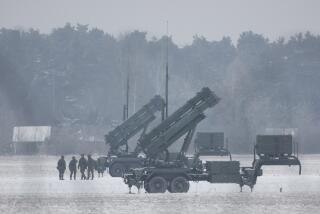Cost of Keeping Nuclear Arms Rises, U.S. Says
- Share via
WASHINGTON — Although the threat of nuclear war has diminished in recent years, the cost of effectively maintaining the nation’s stockpile of nuclear weapons will jump at least an additional $5 billion over the next decade and exceed the price tag during the Cold War, Energy Department officials said Friday.
Without the additional spending, said Energy Secretary Federico Pena, weapons laboratories will be unable to carry out a complex new plan to verify the reliability and safety of nuclear bombs in the absence of underground testing.
For the record:
12:00 a.m. Oct. 4, 1997 For the Record
Los Angeles Times Saturday October 4, 1997 Home Edition Part A Page 3 Foreign Desk 2 inches; 38 words Type of Material: Correction
Nuclear costs--Because of an editing mistake, a story in The Times last Saturday misattributed an assertion that more money will be spent on future maintenance of nuclear weapons than on their production. The statement was made by the Natural Resources Defense Council.
The department’s new estimate of maintaining the nuclear stockpile during the next 10 years is $45 billion, not including the impact of future inflation. Previously, the department had estimated the cost at $40 billion.
Even before the new estimate, critics had lambasted the department’s maintenance plan as unnecessarily ambitious, requiring the construction of six major high energy physics laboratories--some as large as football stadiums.
“This is a cash cow that the design laboratories have created,” said Tom Cochran, a nuclear weapons critic at the Natural Resources Defense Council, a Washington-based environmental group.
The group estimates that the United States spent an average of $3.7 billion a year (in current dollars) during the Cold War producing, testing and maintaining a much larger nuclear weapons stockpile.
But Energy officials said that their plan is essential to maintain confidence in the reliability, safety and security of nuclear weapons, which could no longer be tested underground under the international test ban that President Clinton has asked the Senate to approve. Senate debate on ratifying the treaty is scheduled to start in coming weeks.
In the absence of underground testing, the Energy Department wants to simulate the detonation of a bomb in high-energy physics laboratories and then model the detonation process on computers.
The Energy Department has created the world’s most powerful supercomputer and is attempting to build an even more powerful one that would perform 100 trillion calculations per second--necessary to model a nuclear bomb blast, Pena said.
Victor Reis, assistant Energy secretary for defense programs, said that part of the increased estimate for the maintenance plan stems from the costs of developing new supercomputers.
But outside experts, including influential former IBM executive Richard Garwin, have become increasingly skeptical about the need for the department’s plan.
“You could cut this budget by a third to a half,” Cochran said.
More to Read
Sign up for Essential California
The most important California stories and recommendations in your inbox every morning.
You may occasionally receive promotional content from the Los Angeles Times.














